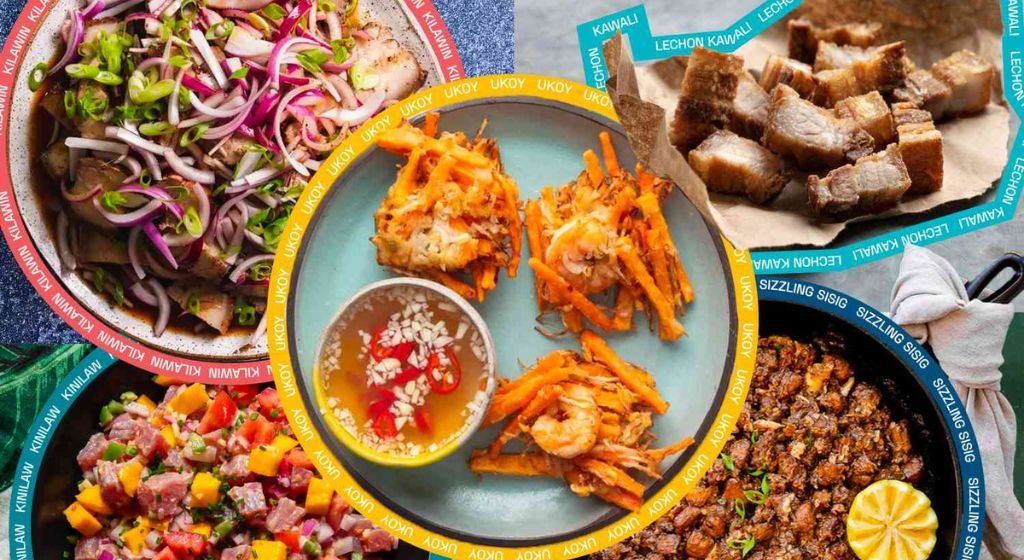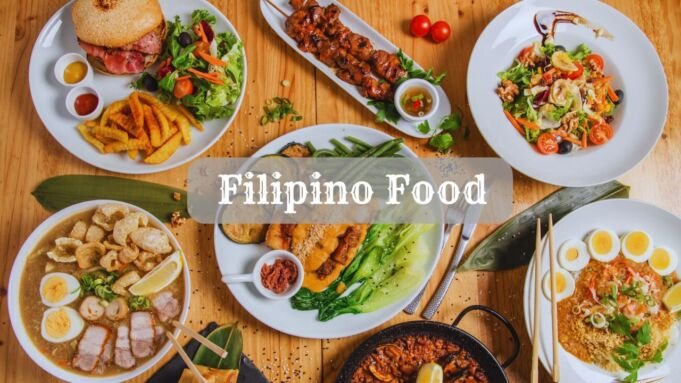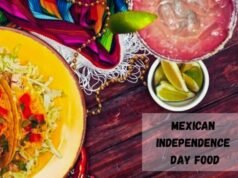Filipino Food is as vibrant and diverse as the archipelago from which it hails. With over 7,000 islands, the Philippines boasts a culinary tradition that encapsulates a blend of indigenous, Asian, Spanish, and American influences, each adding depth to the country’s rich gastronomic heritage.
The typical flavor profiles range from sour and tangy to sweet and savory, using a base of staple ingredients such as rice, coconut, and a variety of fresh seafood.
What is Filipino Food?
Filipino food is a vibrant and eclectic cuisine rooted in the rich history of the Philippines, a melting pot of indigenous, Spanish, American, and Asian influences. It is characterized by a harmonious blend of flavors—sour, sweet, and salty, often brought to life with a touch of tangy calamansi lime or the richness of coconut milk.
Staples like rice, fish, and pork form the backbone of many dishes, while street foods such as balut (fertilized duck egg) and isaw (grilled intestines) reflect the adventurous side of Filipino eating habits. Filipino meals are typically hearty and communal, serving not just to nourish but also to bring families and communities together.
Each dish, whether a simple daily fare like adobo or a festive lechon (roasted pig) during celebrations, tells a story of the nation’s past and its cultural interactions. The cuisine is a testament to the country’s spirit of resilience and its ability to adapt and embrace outside influences while maintaining its unique culinary identity.
Related: Turkish Foods
Historical of Filipino Foods
The culinary history of the Philippines is a narrative of conquests and communal sharing. Before the Spanish colonized the Philippines in the 16th century, Filipinos enjoyed a diet centered around rice, fish, and tropical fruits. The Spanish brought with them new cooking methods and ingredients such as corn, potatoes, and tomatoes, which were gradually integrated into local dishes.
Later, the American occupation introduced Filipinos to processed foods and the concept of fast food, while nearby Asian countries like China and Malaysia influenced Filipino cuisine with noodles and spices.
Get A Taste of Traditional Filipino Foods
A great way to immerse yourself in Filipino cuisine is by cooking these dishes yourself. Whether at cooking classes in the Bay Area, NYC, or any local cooking workshops, engaging directly with the preparation of Filipino meals allows you to fully experience the intricate flavors, textures, and scents that define this rich culinary tradition. To deepen your understanding even further, consider participating in online cooking classes as well.
Key Ingredients and Flavors
At the heart of Filipino cooking lies a trio of flavors: sour, sweet, and salty. Ingredients such as vinegar, soy sauce, and calamansi are indispensable in most kitchens. Coconut milk adds richness to dishes like ginataan, while fish sauce provides a foundational umami flavor. This combination of flavors creates dishes that are complex and balanced, appealing to a broad spectrum of palates.
Popular Filipino Dishes
From the salty tang of Adobo—the unofficial national dish to the sour zest of Sinigang, Filipino cuisine is full of iconic meals. Street foods like Balut (fertilized duck egg), Isaw (chicken intestines), and desserts like Halo-halo (mixed ice dessert) are emblematic of Filipino food culture. Festive foods also play a significant role, with Pancit (noodles) symbolizing long life and Leche Flan providing a sweet end to celebrations.
READ: Lebanese Food
Top 25 Filipino Foods Everyone Should Try in 2025

The rich flavors of the Philippines with this list of 25 must-try dishes. Each one offers a unique taste of Filipino culinary culture, perfect for anyone looking to expand their palate in 2025.
1. Adobo
Adobo is perhaps the most iconic Filipino dish, known for its savory, tangy, and slightly sweet flavor. Typically made with chicken or pork, the meat is marinated in vinegar, soy sauce, garlic, and bay leaves, then simmered until tender. Every family has their own twist on adobo, making it a unique heritage dish to try.
2. Sinigang
Sinigang is a sour soup beloved across the Philippines. Its distinctive tang comes from tamarind, and it often features pork, shrimp, or fish, alongside a variety of vegetables like water spinach, radish, and eggplant. It’s a comforting bowl that encapsulates the Filipino love for sour flavors.
3. Lechon
Lechon refers to a whole roasted pig, slow-cooked over charcoal, and is a centerpiece at many Filipino festivities. The skin becomes incredibly crispy, while the meat stays tender and flavorful, often served with liver sauce or vinegar garlic dip.
4. Kare-Kare
Kare-Kare is a rich and creamy peanut stew typically made with oxtail, tripe, and vegetables such as eggplants and banana blossoms. Served with a side of shrimp paste to enhance its flavors, this dish is a hearty Filipino favorite.
5. Pancit Canton
Pancit Canton is a type of Filipino noodle dish that reflects Chinese influences. These stir-fried noodles are cooked with a variety of meats and vegetables, making them a filling and flavorful meal.
6. Bicol Express
Named after the Bicol region, known for its spicy cuisine, Bicol Express is a fiery dish made with chili, coconut milk, shrimp paste, and pork. It’s a rich, creamy dish with a substantial kick of heat.
7. Halo-Halo
Halo-Halo, which translates to “mix-mix,” is a popular Filipino dessert that includes crushed ice, evaporated milk, and various ingredients like sweetened beans, coconut, and fruits, topped with a scoop of ice cream. It’s a refreshing treat on a hot day.
8. Lumpiang Shanghai
Lumpiang Shanghai is Filipino spring rolls packed with ground pork, onions, and carrots. They are tightly wrapped, fried to crispy perfection, and often served with a sweet and sour sauce.
9. Chicken Inasal
Chicken Inasal is a Visayan barbecue specialty from Bacolod. The chicken is marinated in a mixture of lime, pepper, vinegar, and annatto, and then grilled over hot coals. It’s flavorful and best enjoyed with a serving of garlic rice.
10. Arroz Caldo
Arroz Caldo is a Filipino congee made with chicken and rice and seasoned with garlic, onions, and ginger. Often served as a comfort food during rainy weather, it’s garnished with green onions, fried garlic, and a squeeze of lemon or calamansi.
11. Tapsilog
Tapsilog is a breakfast staple combining tapa (cured beef), sinangag (garlic fried rice), and itlog (fried egg). It’s a hearty and satisfying meal to start the day.
12. Dinuguan
Dinuguan is a Filipino savory stew made of pork blood, meat, and intestines. Seasoned with garlic, chili, and vinegar, this dish has a rich, spicy-sour flavor profile that challenges the palate but rewards the adventurous eater.
13. Puto
Puto are steamed rice cakes, often enjoyed as a snack or dessert. These fluffy, bouncy cakes are frequently paired with savory dishes like dinuguan or served during special occasions and gatherings.
14. Bibingka
Bibingka is a type of rice cake that’s especially popular during the Christmas season. Made from rice flour, coconut milk, and eggs, and cooked in a clay pot lined with banana leaves, it has a unique, slightly sweet flavor and a soft, spongy texture.
READ: Venezuelan Food
15. Sisig
Sisig is a cap-off dish made from parts of pig’s head and liver, usually seasoned with calamansi and chili peppers. Originally from Pampanga, sisig is a staple of Filipino “pulutan” and is increasingly popular as a main dish as well.
16. Laing
Laing is a Bicolano dish made from dried taro leaves slowly cooked in coconut milk, chili, and shrimp paste. It’s a creamy, spicy dish that perfectly illustrates the rich use of coconut in regional Filipino cooking.
17. Kinilaw
Kinilaw is Filipino ceviche, wherein raw fish is marinated in vinegar, lime, or lemon juice, with onions, ginger, and chili peppers. It’s a fresh, acidic dish that highlights the quality of local seafood.
18. Balut
Balut is a street food delicacy not for the faint-hearted. This fertilized duck egg with a partially developed embryo is boiled and eaten from the shell. Often served with a pinch of salt and vinegar, it’s considered both a delicacy and a test of courage for visitors.
19. Morcon
Morcon is a Filipino-style meat roll filled with sausage or hotdogs, carrots, pickles, cheese, and eggs. This hearty dish is commonly served during festive occasions and is a true feast for the eyes and the palate.
20. Pinakbet
Pinakbet or Pakbet is a vegetable stew flavored with shrimp paste. It includes bitter melon, eggplant, tomato, okra, and string beans and is typically combined with bits of pork. It’s a staple dish that showcases local vegetables.
21. Taho
Taho is a sweet treat made from fresh soft/silken tofu, arnibal (syrup), and sago pearls. This warm snack is often carried by vendors in buckets around neighborhoods each morning.
22. Kaldereta
Kaldereta is a hearty Filipino beef stew made with liver spread, tomatoes, potatoes, and bell peppers. It’s a rich dish often spiced up with chili peppers and traditionally served at parties and family gatherings.
23. Sinampalukang Manok
Sinampalukang Manok is a soup similar to Sinigang, distinguished by its use of young tamarind leaves as the souring agent. It’s a soothing, tangy soup that is perfect for nursing a cold or enjoying on a rainy day.
24. Longganisa
Longganisa refers to Filipino sausages, which are often sweet or garlicky depending on the region they come from. These are popular for breakfast with garlic rice and eggs.
25. Turon
Turon is a sweet snack made from banana or jackfruit wrapped in a spring roll wrapper and deep-fried. Often coated in caramelized sugar, Turon is crunchy on the outside, sweet and gooey on the inside, making it a beloved afternoon snack.
Regional Variations
The Philippine archipelago is divided into three key regions, each with its distinct culinary identity. Luzon is known for its sophisticated paellas and cochinita pibil, a slow-roasted pork dish, reflective of its Spanish influences. The Visayas are famous for their seafood and Kinilaw (a raw fish salad), while Mindanao showcases spicy dishes influenced by its proximity to other Southeast Asian countries.
Read More: Best Restaurants in Gatlinburg for Every Food Lover
Eating Habits and Meal Customs
Filipinos typically enjoy three main meals a day, supplemented by smaller, snack-like meriendas. Meals are communal affairs, often shared family style, reflecting the Filipino value of kapwa (togetherness). Eating with hands, known as Kamayan, is not just a method of eating, but a cherished tradition that emphasizes connection and simplicity.
What is the Philippine National Dish?
The Philippines’ national dish, often considered to be Adobo, is a quintessential example of the country’s culinary heritage. This beloved recipe is emblematic of Filipino cooking, featuring meat, seafood, or vegetables marinated in vinegar, soy sauce, garlic, and black peppercorns, then browned in oil, and simmered in the marinade.
Adobo’s simple yet robust flavor profile showcases the Filipino palate’s affinity for combining salty, sour, and savory tastes. Its versatility and ease of preparation have made it a staple in homes across the archipelago, with each region adding its own twist to the dish, reflecting the diversity and creativity inherent in Filipino cuisine.
READ: Nigerian Food
What is Pinoy’s Favorite Food?
Pinoy cuisine, with its rich and varied flavors, offers a wide array of beloved dishes, but one stands out as a national favorite: Adobo. This quintessential Filipino dish is cherished across the archipelago and varies from region to region, each adding its own twist to the basic ingredients of vinegar, soy sauce, garlic, and pepper. Adobo’s appeal lies in its versatility; it can be made with chicken, pork, or a combination of both, and is delicious when freshly made or as a flavorful leftover.
Its savory, tangy, and slightly sweet sauce makes it a comfort food for many Filipinos and a must-try for those exploring Pinoy culinary traditions. Often served with steamed rice, Adobo holds a special place in the hearts and kitchens of Filipinos, embodying the essence of Filipino home cooking.
Filipino Food in the Global Context
As Filipino communities have grown abroad, so too has the footprint of Filipino cuisine. Restaurants serving Sisig (a sizzling pork dish) and Adobo are becoming more common in cities around the world. Fusion dishes that incorporate Filipino flavors into other cuisines are also helping to introduce Filipino food to a broader audience.
Read Also: AirFood Recipes
Challenges and Future Trends
Despite its rich heritage, Filipino cuisine faces challenges such as the modernization of traditional recipes and the health implications of its traditionally meat-heavy and salty dishes. In response, a new wave of chefs and culinary enthusiasts are exploring healthier versions of traditional dishes and experimenting with plant-based ingredients.
Frequently Asked Questions (FAQs)
What are the basic flavor profiles of Filipino cuisine?
Filipino dishes typically blend sweet, sour, and salty flavors, often featuring ingredients like vinegar, soy sauce, sugar, and citrus fruits like calamansi. This combination creates a unique taste that defines many traditional Filipino recipes.
What is considered the national dish of the Philippines?
Adobo is often considered the national dish of the Philippines. This popular dish is versatile and involves marinating meat, usually chicken or pork, in a mixture of vinegar, soy sauce, garlic, and black peppercorns, then simmering it until tender.
Are there any vegetarian options in Filipino cuisine?
While Filipino cuisine is known for its emphasis on meat and seafood, there are several vegetarian options available, such as Pinakbet (a vegetable stew with squash, eggplant, okra, and string beans) and Laing (taro leaves cooked in coconut milk).
What is a typical Filipino breakfast?
A traditional Filipino breakfast might include silog – a term that combines the words for fried rice (sinangag) and egg (itlog). Popular silog dishes include Tapsilog (with cured beef), Longsilog (with Filipino sausage), and Bangsilog (with fried fish).
How does Filipino street food differ from restaurant dishes?
Filipino street food is often quicker, more casual, and imbued with bold flavors compared to restaurant dishes. Common street foods include Balut (fertilized duck egg), Isaw (chicken or pork intestines), and Taho (soft tofu with syrup and sago pearls).
Can Filipino dishes be made healthier?
Traditional Filipino dishes can be modified for health-conscious eaters. For example, using less sodium by reducing soy sauce and replacing pork with leaner meats like chicken or even plant-based proteins can make dishes healthier without compromising their authentic taste.
What are some must-try desserts in Filipino cuisine?
Filipino desserts are diverse and richly flavored. Halo-halo, a mixed dessert of shaved ice, evaporated milk, and various ingredients like sweet beans, coconut, and fruits, is a must-try. Other favorites include Bibingka (rice cake), Leche Flan (caramel custard), and Ube Halaya (purple yam jam).
Conclusion
Filipino cuisine is a dynamic and evolving aspect of the country’s culture, reflective of its history, diverse influences, and the Filipino spirit of community. As it gains more international recognition, Filipino food continues to evolve while staying rooted in the flavors that make it unique. This gastronomic journey is a testament to the Philippines’ rich cultural tapestry and its enduring appeal on the global culinary stage.
















[…] Top 25 Filipino Foods Everyone Should Try in 2024 […]
Comments are closed.